Not For The Faint-Hearted. Or at least, not for those who are afraid of seeing the DEAD.
If you know me well enough, you would know of my interest in the field of the paranormal phenomenon. I love sharing and exchanging tales of "experiences" with family and friends. I love watching "A Haunting" where the team of investigators would set up cameras around the haunted place to observe the paranormal activities. Some of them would then tour the area with devices to trace for unusual situations like a change in temperature. I am always at the edge of my seat whenever I see episodes whereby the ghost is furious and would make noises or toss items about.
I do support the local "Ghost Busters" (SPI) too, by visiting their website frequently to read the stories and follow up on the investigations. I don't know about you, but I would always place myself in the settings, as if I too, were involved in the paranormal investigations. I would then question (sometimes aloud) as to why the ghost is doing this, what am I supposed to do, what clues are there, how come their spirits are still around, how does it feel and so on. You get what I mean.
Anyway, last night, I watched a show on the National Geographic Channel called "Sleeping Beauties: The Incorruptibles." And a new question rose to the surface: Why do Saints leave their incorruptible bodies behind? I don't know if any of you caught the show. And if you didn't and have no clue as to what I am talking about, fear not! Wikipedia to the rescue!
Incorruptibility is the Catholic and Orthodox Christian belief that supernatural intervention allows some human bodies to not undergo the normal process of decomposition after death. Bodies that reportedly undergo little or no decomposition are sometimes referred to as incorrupt or incorruptible (adjective) or as an incorruptible (noun).
Incorruptibility is seen as distinct from the good preservation of a body, or mummification. Incorruptible bodies are often said to have the Odour of Sanctity, exuding a sweet aroma. However, despite numerous claims, there are no scientifically verified cases of genuine incorruptibility.
I was curios.. So more research!
From http://www.overcomeproblems.com/incorruptables.htm (It's an attack site, So I guess no one's going to click on it huh?)
Specimens of preserved human bodies or "mummies" have been discovered throughout the centuries, some even from before the Egyptian Pharaoh times when the art of embalming originated. Many of these preserved bodies have survived decomposition for as many as 3000 years. Of all preserved bodies that have been discovered over the centuries, each fall into one of three categories:
1. Accidentally preserved - These type of preserved bodies were determined to be naturally preserved due to accidental means such as having been buried in dry, hot sand, or lava, or having been placed in an area with high radioactivity. As long as air or moisture did not reach these bodies, they can many times be preserved from significant, but not total decay. However, when accidentally preserved bodies are discovered, they are typically discolored, wrinkled, distorted, are skeletal looking and have no elasticity. In addition they always have a bad odor and always decay rapidly once bandaging is removed for scientific examination.
2. Deliberately preserved - Deliberately preserved corpses are those that were purposely embalmed or otherwise treated before burial with the intention of trying to naturally prevent decomposition. As long as air or moisture did not reach these bodies, they can many times be preserved from significant, but not total decay. In most older cases of deliberately preserved human bodies discovered, the body cavities were filled with specific materials like resin or resin-soaked sawdust, or the entire body was submerged in specific materials such as honey, rum, or sand. In more modern methods of attempting to prevent corpse decomposition, the body was typically submerged or filled with resin, tar, salt, alcohol, or a combination of these. Again, when deliberately preserved bodies are discovered, like accidentally preserved bodies, they are typically discolored, wrinkled, distorted, are skeletal looking and have no elasticity. In addition they always have a bad odor and always decay rapidly once bandaging is removed for scientific examination.
3. Incorruptibles - These type of preserved bodies started being discovered back in the early centuries after Christ, though surprisingly, they do not fall into either the accidental or deliberate preservation categories above. The causes for "incorruptibles" remaining free of decomposition have baffled scientists to this day. These bodies are discovered in many different environments, including environments that would typically cause an accidental or deliberately preserved corpse to decompose rapidly. They remain free of decay regardless of manner of burial, delay in burial, temperature, moisture, rough handling, frequent transference, having been covered in quicklime (a decaying agent), or proximity to other decaying corpses. They cannot be explained by science or reason. Some common characteristics of an incorrupt body:
|
| Incorruptibles are typically found lifelike, moist, flexible, and contain a sweet scent that many say smells like roses or other flowers, for years after death. |
|
| Incorruptibles are almost never embalmed or treated in any way due to the religious order's beliefs that the person came from. |
|
| Incorruptibles remain free of decay, some for centuries, despite circumstances which normally cause decay such as being exposed to air, moisture, other decaying bodies, or other variables such as quicklime, which is typically applied to a corpse to accelerate decomposition. |
|
| Incorruptibles many times contain clear, flowing oils, perspiration, and flowing blood for years |
|
| Other partial incorruptibles have been found throughout the centuries where certain parts of the body decay normally, while other parts such as the heart or tongue remain perfectly free of decomposition. |
What is most astounding of all is the fact that for each incorrupt body discovered, after research has been done to determine who the person was, it has always been determined that the person was an extremely devout Catholic. This inevitably leads to the question, How can the process of decay, which has no intelligence, choose which bodies to devour and not to devour, and why do they happen to be devout Catholics? (For claims of incorrupt Orthodox Christians, please see our page on the subject here.) There is no other way to describe this phenomena than to state that it is supernatural rather than natural, and that it is simply miraculous.
In addition, many unexplainable miracles have occurred throughout history when people have come in contact with these incorrupt remains, and despite regular medical examinations, scientists have not determined why. These incorrupt bodies are on display all over the world to this day (mainly in Europe), and nearly all bodies who have been identified and whose background has been researched thoroughly, have been canonized by the Catholic Church as Saints due to their publicly devout Catholic life.
Note that some incorrupt bodies that have been discovered and placed on display have had make up or wax added to them to improve their appearance. This is due to the fact that some bodies, while incorrupt, may not appear as beautiful as others, or may only be partially incorrupt while others are fully incorrupt. To those non-believers reading this page, these minor touch-ups are irrelevant when it comes to the state of a body's incorruptibility; no amount of make up or wax could possibly prevent these bodies (some centuries old!) from decaying once placed on display. The majority of incorrupt bodies remain incorrupt after being put on display, regardless of whether they have been touched up or not.
If you still have no idea, then let me show you. There's actually a list of them. I'll try to find all the pictures.
It's going to be alittle freaky.
Here goes:
Jacinta Marto - Jacinta Marto was one of the three original visionaries at
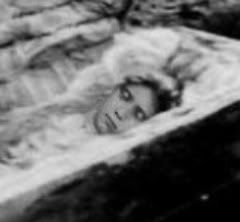
Saint Frances Xavier Cabrini - Also known as Mother Cabrini, she died in
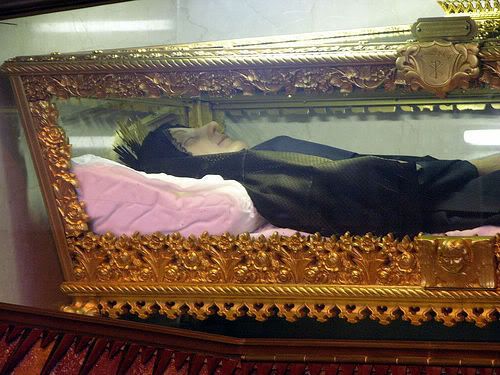
Pope St. Pius X - Pope St. Pius X was the 257th Catholic Pope, reigning from 1903 to 1914. He passed away on

Following his beatification, on
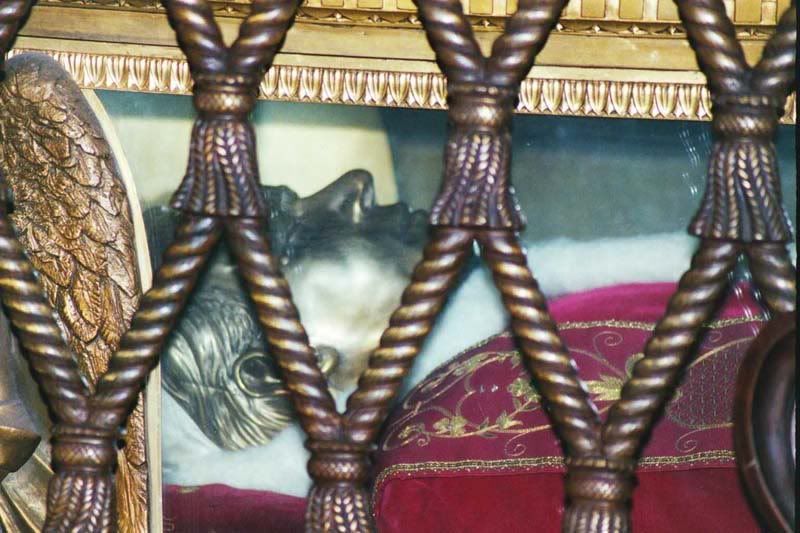
Saint Maria Mazzarello - Died in 1881 and was later discovered incorrupt. Her incorrupt body is venerated in the Basilica of Mary Our Help, in


Blessed Paula Frassinetti - Died in 1882 and her body was exhumed and found to be incorrupt in 1906. Her body is on display in the Chapel of the Convent of Santa Dorotea in
St. Catherine Laboure' - Died in 1876 and was exhumed and found incorrupt and completely flexible in 1933. Her body is on display under the side altar in the Chapel of Our Lady of the Sun in
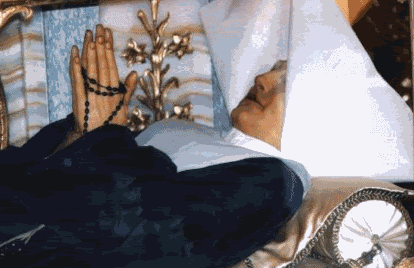

St. Jean-Marie-Baptiste Vianney (Cure' of Ars) - Died in 1859 and was exhumed and found incorrupt in 1904. His body is on display above the main altar in the Basilica at Ars in

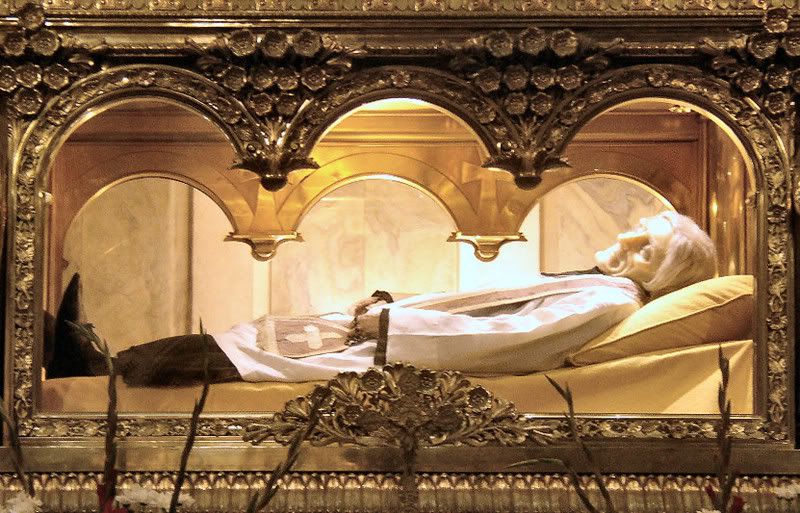
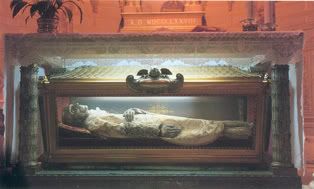
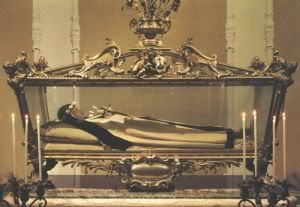
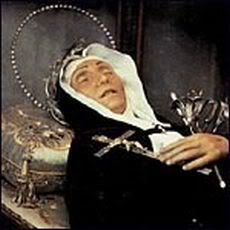
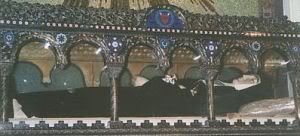
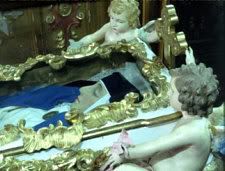
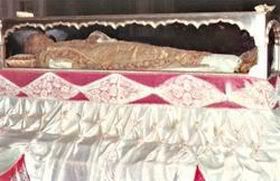
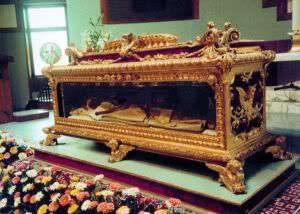
St. Catherine of
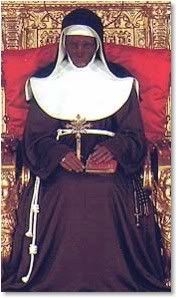
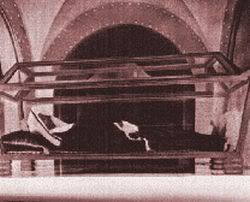
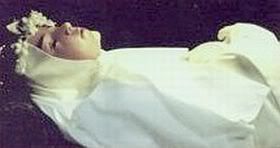


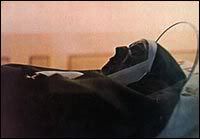
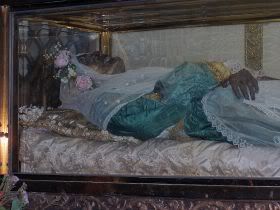
Saint Alphege - Was Archbishop of
Saint Withburga - Died in 743 and incorrupt body was discovered 55 years later. Her remains were on display for over 300 more years thereafter until destroyed during the Reformation.
Saint Etheldreda - Died in 679 and was later found incorrupt. Her remains were intact for nearly 800 years until the Reformation when, at the orders of Henry VIII, her relics were scattered and shrine destroyed.
Saint Agatha - Died in 251 and body was discovered incorrupt in the eleventh century. Parts of her incorrupt body are still in existence today.
Saint Cecilia - Died in 177 and her body was discovered incorrupt in 1599. St. Cecilia is known to be the first saint to be incorrupt. Below is a statue of St. Cecilia created during the exhumation of her incorrupt body in 1599. The position is the same as the actual body and is believed to be the position in which she died. The statue is located in the Basilica of St. Cecilia in
Loves.

No comments:
Post a Comment